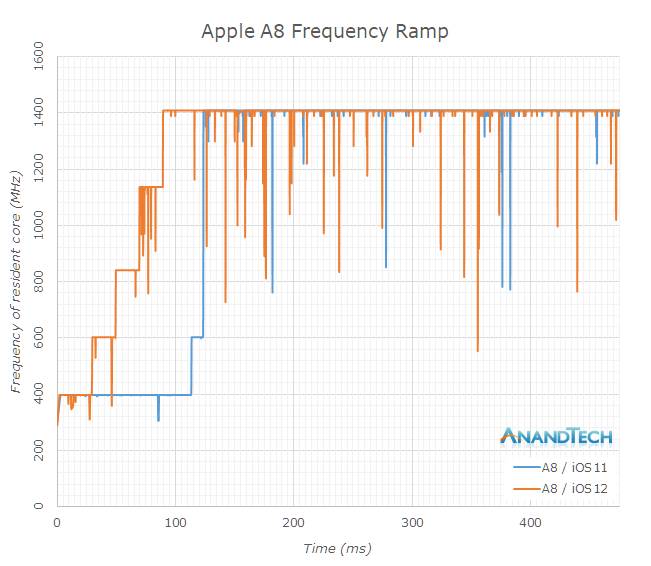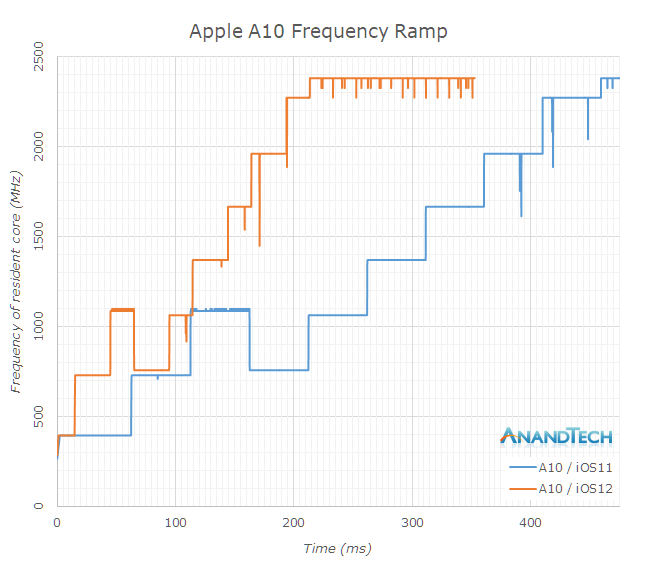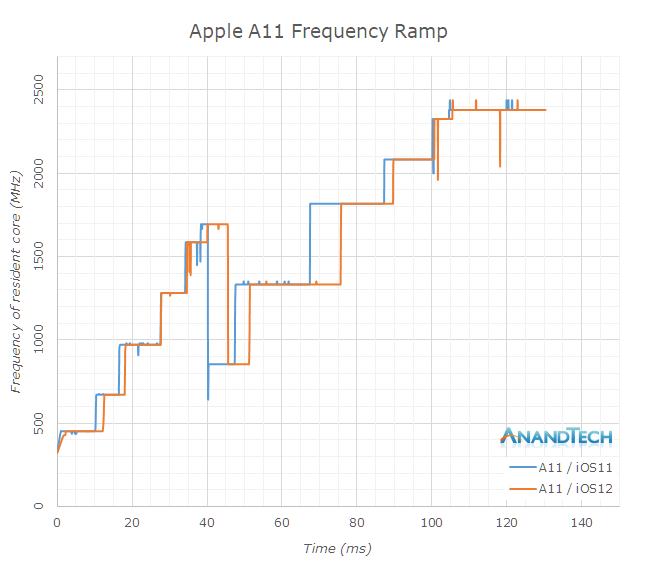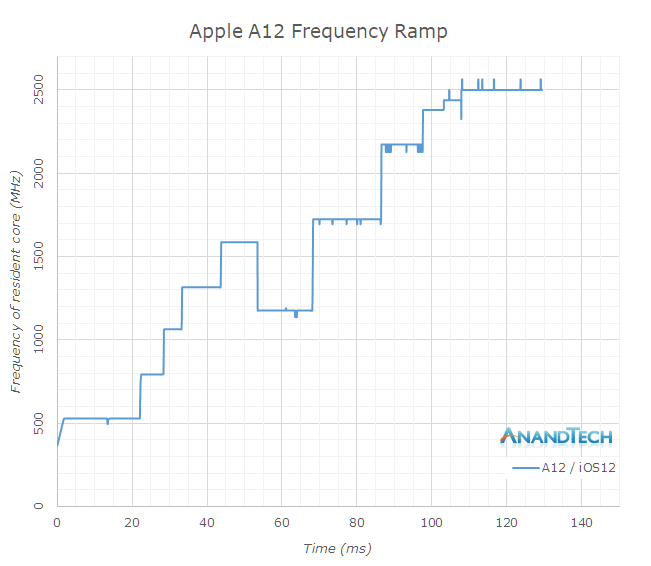The iPhone XS & XS Max Review: Unveiling the Silicon Secrets
by Andrei Frumusanu on October 5, 2018 8:00 AM EST- Posted in
- Mobile
- Apple
- Smartphones
- iPhone XS
- iPhone XS Max
System Performance
While synthetic test performance is one thing, and hopefully we’ve covered that well with SPEC, interactive performance in real use-cases behaves differently, and here software can play a major role in terms of the perceived performance.
I will openly admit that our iOS system performance suite looks extremely meager: we are only really left with our web browser tests, as iOS is quite lacking in meaningful alternatives such as to PCMark on the Android side.

Speedometer 2.0 is the most up-to-date industry standard JavaScript benchmark which tests the most common and modern JS framework performance.
The A12 sports a massive jump of 31% over the A11, again pointing out that Apple’s advertised performance figures are quite underselling the new chipset.
We’re also seeing a small boost from iOS 12 on the previous generation devices. Here the boost comes not only thanks to an a change in how iOS’s scheduler handles load, but also thanks to further improvements in the ever evolving JS engine that Apple uses.

WebXPRT 3 is also a browser test, however its workloads are more wide-spread and varied, containing also a lot of processing tests. Here the iPhone XS showcases a smaller 11% advantage over the iPhone X.
Former devices here also see a healthy boost in performance, with the iPhone X ticking up from 134 to 147 points, or 10%. The iPhone 7’s A10 sees a larger boost of 33%, something we’ll get into more detail in a little bit.
iOS12 Scheduler Load Ramp Analyzed
Apple promised a significant performance improvement in iOS12, thanks to the way their new scheduler is accounting for the loads from individual tasks. The operating system’s kernel scheduler tracks execution time of threads, and aggregates this into an utilisation metric which is then used by for example the DVFS mechanism. The algorithm which decides on how this load is accounted over time is generally simple a software decision – and it can be tweaked and engineered to whatever a vendor sees fit.
Because iOS’s kernel is closed source, we’re can’t really see what the changes are, however we can measure their effects. A relatively simple way to do this is to track frequency over time in a workload from idle, to full performance. I did this on a set of iPhones ranging from the 6 to the X (and XS), before and after the iOS12 system update.
Starting off with the iPhone 6 with the A8 chipset, I had some odd results on iOS11 as the scaling behaviour from idle to full performance was quite unusual. I repeated this a few times yet it still came up with the same results. The A8’s CPU’s idled at 400MHz, and remained here for 110ms until it jumped to 600MHz and then again 10ms later went on to the full 1400MHz of the cores.
iOS12 showcased a more step-wise behaviour, scaling up earlier and also reaching full performance after 90ms.
The iPhone 6S had a significantly different scaling behaviour on iOS11, and the A9 chip’s DVFS was insanely slow. Here it took a total of 435ms for the CPU to reach its maximum frequency. With the iOS12 update, this time has been massively slashed down to 80ms, giving a great boost to performance in shorter interactive workloads.
I was quite astonished to see just how slow the scheduler was before – this is currently the very same issue that is handicapping Samsung’s Exynos chipsets and maybe other Android SoCs who don’t optimise their schedulers. While the hardware performance might be there, it just doesn’t manifest itself in short interactive workloads because the scheduler load tracking algorithm is just too slow.
The A10 had similar bad characteristics as the A9, with time to full performance well exceeding 400ms. In iOS12, the iPhone 7 slashes this roughly in half, to around 210ms. It’s odd to see the A10 being more conservative in this regard compared to the A9 – but this might have something to do with the little cores.
In this graph, it’s also notable to see the frequency of the small cores Zephyr cores – they start at 400MHz and peak at 1100MHz. The frequency in the graph goes down back to 758MHz because at this point there was a core switch over to the big cores, which continue their frequency ramp up until maximum performance.
On the Apple A11 – I didn’t see any major changes, and indeed any differences could just be random noise between measuring on the different firmwares. Both in iOS11 and iOS12, the A11 scales to full frequency in about 105ms. Please note the x-axis in this graph is a lot shorter than previous graphs.
Finally on the iPhone XS’s A12 chipset, we can’t measure any pre- and post- update as the phone comes with iOS12 out of the box. Here again we see that it reaches full performance after 108ms, and we see the transition of the tread from the Tempest cores over to the Vortex cores.
Overall, I hope this is the best and clear visual representation of the performance differences that iOS12 brings to older devices.
In terms of the iPhone XS – I haven’t had any issues at all with performance of the phone and it was fast. I have to admit I’m still a daily Android user, and I use my phones with animations completely turned off as I find they get in the way of the speed of a device. There’s no way to completely turn animation off in iOS, and while this is just my subjective personal opinion, I found they are quite hampering the true performance of the phone. In workloads that are not interactive, the iPhone XS just blazed through them without any issue or concern.















253 Comments
View All Comments
Andrei Frumusanu - Sunday, October 7, 2018 - link
Smartphones can sustain 3-3.5W. There's a window of several minutes where you can maintain peak. However because CPU workloads are bursty, it's rare that you would hit thermal issues in usual scenarios. Sustained scenarios are games, but there the GPU is the bottleneck in terms of power.Batteries easily sustain 1C discharge rate, for the XS' that's 2.6 and 3.1A, or rounded to around 10 to 12W. Temperature becomes a natural limitations before the battery discharge rate becomes any concern.
Javert89 - Sunday, October 7, 2018 - link
Thanks for the reply. My look on the battery was long term, in the past there has been the 'throttling fiasco' in which the performance of the device was cut down because batteries seemingly could not hold the power requested.. If the power draw increased on the A12, I could wonder if the problem will get worseConstructor - Sunday, October 7, 2018 - link
The whole panic about the iPhone 6 on old, softening batteries was basically just this, but after one relatively crude attempt they got the power management optimized that I had very little if any slowdown even on my 4 years old battery.The crash during the extreme load test on the XS will of course need to get fixed with another power management update, just that it needs to apply even to factory-fresh batteries already.
But when the battery ages and its current delivery capability erodes over time it will only become more and more necessary for power management to deal with such spikes, possibly by ramping up the clock less aggressively.
iAPX - Sunday, October 7, 2018 - link
This test is a master piece. Kudos!TheSparda - Sunday, October 7, 2018 - link
I am interested to know more the recent issues with the poor wifi & LTE speeds and signal strength. A smartphone having great cpu/gpu is good and all, but some of the basics such as wifi & LTE should also be up to snuff if apple wants to phone to be a total package. I feel that the wifi & LTE issues are overlooked when they designed the phone.FunBunny2 - Monday, October 8, 2018 - link
"I feel that the wifi & LTE issues are overlooked when they designed the phone."see my earlier comment, to wit: if you want to make a clear phone call, get a landline.
varase - Tuesday, October 23, 2018 - link
It already seems fixed in 12.1 beta 3, and may have been fixed in 12.0.1 but I don't have that installed.lucam - Sunday, October 7, 2018 - link
I was sure that the GPU used on A11 and A12 are basically Imagination Tech solutions and Apple can't design a completely new GPU solution from scratch.I am wondering if Apple will use the future Furian solution or not in future chips; if they won't as they don't partner anymore they will regret it.
Question is what's the current agreement with Imagination as they are still using PowerVR solutions.
tipoo - Wednesday, October 24, 2018 - link
Even with the A10, their GPU was 2/3rds custom, their arrangement with Imagination seems similar to their ARM licence. Calling it custom as of the A11 even though not that much seemed to change (but for grouping more ALUs into a core) seems like a formality.https://www.realworldtech.com/apple-custom-gpu/
Calin - Monday, October 8, 2018 - link
You could do some tests in "Airplane" mode to eliminate the WiFi and telephony stack power use.I'm not sure there's a way to eliminate the telephony stack but still keep the WiFi active.